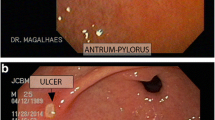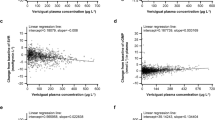Abstract
Objective
Induction of CYP3A by St. John’s wort (SJW) products with high hyperforin content is well described. Since CYP3A induction is mediated by hyperforin in a concentration-dependent manner, and SJW preparations differ significantly in hyperforin content, the aim of the study was to evaluate the effect of an SJW powder with low hyperforin content on CYP3A function.
Methods
Twenty healthy male volunteers received an SJW powder with low hyperforin content for 2 weeks. Midazolam plasma concentration time profiles were characterized after a single oral dose of 7.5 mg midazolam on the day before and on the 14th day of SJW medication.
Results
Midazolam AUC0–∞ slightly decreased from 124.0 ± 62.5 ng/ml·h at baseline to 105.6 ± 53.2 ng/ml·h after SJW (P < 0.05), representing a mean 11.3% decrease (95% CI: −22.8 to 0.21). No significant change in midazolam Cmax, t1/2 and tmax was observed. For all pharmacokinetic parameters, the 90% CI for the geometric mean ratio of treatment over baseline were within the no-effect boundaries of 0.70–1.43.
Conclusion
Administration of an SJW product with low hyperforin content resulted in a mild induction of CYP3A not considered clinically relevant.

Similar content being viewed by others
References
Butterweck V (2003) Mechanism of action of St. John’s wort in depression—what is known? CNS Drugs 17:539–562
Butterweck V, Schmidt M (2007) St. John’s wort: role of active compounds for its mechanism of action and efficacy. Wien Med Wochenschr 157:356–361
Zanoli P (2004) Role of hyperforin in the pharmacological activities of St. John’s wort. CNS Drug Rev 10:203–218
Butterweck V, Nahrstedt A, Evans J, Hufeisen S, Rauser L, Savage J, Popadak B, Ernsberger P, Roth BL (2002) In vitro receptor screening of pure constituents of St. John’s wort reveals novel interactions with a number of GPCRs. Psychopharmacology 162:193–202
Melzer M, Fuhrken D, Kolkmann R (1998) Hyperforin im Johanniskraut – Hauptwirkstoff oder nur Leitsubstanz? Dtsch Apoth Ztg 138:56–62
Madabushi R, Frank B, Drewelow B, Derendorf H, Butterweck V (2006) Hyperforin in St. John’s wort drug interactions. Eur J Clin Pharmacol 62:225–233
De los Reyes GC, Koda RT (2002) Determining hyperforin and hypericin content in eight brands of St. John’s wort. Am J Health Syst Pharm 59:545–547
Draves AH, Walker SE (2003) Analysis of the hypericin and pseudohypericin content of commercially available St. John’s wort preparations. Can J Clin Pharmacol 10:114–118
Wurglics M, Westerhoff K, Kaunzinger A, Wilke A, Baumeister A, Dressman J, Schubert-Zsilavecz M (2001) Comparison of German St. John’s wort products according to hyperforin and total hypericin content. J Am Pharm Assoc 41:560–566
Schrader E (2000) Equivalence of St. John’s wort extract (Ze 117) and fluoxetine: a randomized, controlled study in mild-moderate depression. Int Clin Psychopharmacol 15:61–68
Woelk H (2001) Comparison of St. John’s wort and imipramine for treating depression: a randomised controlled trial. BMJ 321:536–539
Whitten DL, Myers SP, Hawrelak JA, Wohlmuth H (2006) The effect of St. John’s wort extracts on CYP3A: a systematic review of prospective clinical trials. Br J Clin Pharmacol 62:512–526
Mannel M (2004) Drug interactions with St. John’s wort – mechanisms and clinical implications. Drug Saf 27:773–797
Dürr D, Stieger B, Kullak-Ublick GA, Rentsch KM, Steinert HC, Meier PJ, Fattinger K (2000) St. John’s wort induces intestinal p-glycoprotein/MDR1 and intestinal and hepatic CYP3A4. Clin Pharmacol Ther 68:598–604
Moore LB, Goodwin B, Jones SA, Wisely GB, Serabjit-Singh CJ, Willson TM, Collins JL, Kliewer SA (2000) St. John’s wort induces hepatic drug metabolism through activation of the pregnane X receptor. Proc Natl Acad Sci USA 97:7500–7502
Wentworth JM, Agostini M, Love J, Schwabe JW, Chatterjee VKK (2000) St. John’s wort, a herbal antidepressant, activates the steroid X receptor. J Endocrinol 166:R11–R16
Gödtel-Armbrust U, Metzger A, Kroll U, Kelber O, Wojnowski L (2007) Variability in PXR-mediated induction of CYP3A4 by commercial preparations and dry extracts of St. John’s wort. Naunyn Schmiedberg’s Arch Pharmacol 375:377–382
Komoroski BJ, Zhang S, Cai H, Hutzler JM, Frye R, Tracy TS, Strom SC, Lehmann T, Ang CYW, Cui YY, Venkataramanan R (2004) Induction and inhibition of cytochromes P450 by the St. John’s wort constituent hyperforin in human hepatocyte cultures. Drug Metab Dis 32:512–518
Mueller SC, Majcher-Peszynska J, Uehleke B, Klammt S, Mundkowski RG, Miekisch W, Sievers H, Bauer S, Frank B, Kundt G, Drewelow B (2006) The extent of induction of CYP3A by St. John’s wort varies among products and is linked to hyperforin dose. Eur J Clin Pharmacol 62:29–36
Mai I, Bauer S, Perloff ES, Johne A, Uehleke B, Frank B, Budde K, Roots I (2004) Hyperforin content determines the magnitude of the St. John’s wort – cyclosporine drug interaction. Clin Pharmacol Ther 76:330–340
Arold G, Donath F, Maurer A, Diefenbach K, Bauer S, Henneicke von Zepelin HH, Friede M, Roots I (2005) No relevant interaction with alprazolam, caffeine, tolbutamide, and digoxin by treatment with a low-hyperforin St. John’s wort extract. Planta Med 71:331–337
Huang SM, Temple R, Throckmorton DC, Lesko LJ (2007) Drug interaction studies: study design, data analysis, and implications for dosing and labeling. Clin Pharmacol Ther 81:298–304
Gaedcke F (1997) Johanniskraut und dessen Zubereitungen. Dtsch Apoth Ztg 137:3753–3757
Hölzl J, Ostrowski E (1987) Johanniskraut (Hypericum perforatum): HPLC-Analyse der wichtigen Inhaltsstoffe und deren Variabilität in einer Population. Dtsch Apoth Ztg 127:1227–1230
Miekisch W, Fuchs P, Berg A, Nöldge-Schomburg G, Drewelow B, Mundkowski R (2003) An improved GC/MS method for the determination of midazolam in human plasma [abstract]. Int J Clin Pharmacol Ther 4:560
U.S. Food and Drug Administration (2001) Guidance for industry – bioanalytical method validation. http://www.fda.gov/CDER/GUIDANCE/4252fnl.htm. Accessed 15 August 2008
U.S. Food and Drug Administration (1994) Reviewer guidance – validation of chromatographic methods. http://www.fda.gov/CDER/GUIDANCE/cmc3.pdf. Accessed 15 August 2008
Ring BJ, Patterson BE, Mitchell MI, Vandenbranden M, Gillespie J, Bedding AW, Jewell H, Payne CD, Forgue ST, Ecksetin J, Wrighton SA, Phillips DL (2005) Effect of tadalafil on cytochrome P450 3A4 – mediated clearance: studies in vitro and in vivo. Clin Pharmacol Ther 77:63–75
Johnson BM, Song IH, Adkison KK, Borland J, Fang L, Lou Y, Berrey MM, Nafziger AN, Piscitelli SC, Bertino JS (2006) Evaluation of the drug interaction potential of aplaviroc, a novel human immunodeficiency virus entry inhibitor, using a modified Cooperstown 5 + 1 cocktail. J Clin Pharmacol 46:577–587
Wang Z, Gorski C, Hamman MA, Huang S-M, Lesko LJ, Hall SD (2001) The effects of St. John’s wort (Hypericum perforatum) on human cytochrome P450 activity. Clin Pharmacol Ther 70:317–326
Dresser GK, Schwarz UI, Wilkinson GR, Kim RB (2003) Coordinate induction of both cytochrome P4503A and MDR1 by St. John’s wort in healthy subjects. Clin Pharmacol Ther 73:41–50
Acknowledgements
We thank Jana Spaller for organizational assistance, Grit Haase for assistance in taking blood samples, and Annette Berg, Liane Krause, and Antje Schümann for processing of samples. The study was supported with funding from the following companies in Germany that have an interest in St. John’s wort: Kneipp Werke, Würzburg; MCM Klosterfrau GmbH, Köln; Phytolab GmbH, Vestenbergsgreuth; Bad Heilbrunner GmbH, Bad Heilbrunn; Merz Consumer Care GmbH, Frankfurt; GlaxoSmithKline GmbH, Bühl; Salus-Haus, Bruckmühl.
Conflicts of interest statement:
Dr. H. Sievers and Dr. R. Lehnfeld are employees of Phytolab GmbH, and Dr. B. Frank is an employee of Kneipp Werke. Both companies have an interest in St. John’s wort. The other authors declared no conflict of interest.
Author information
Authors and Affiliations
Corresponding author
Rights and permissions
About this article
Cite this article
Mueller, S.C., Majcher-Peszynska, J., Mundkowski, R.G. et al. No clinically relevant CYP3A induction after St. John’s wort with low hyperforin content in healthy volunteers. Eur J Clin Pharmacol 65, 81–87 (2009). https://doi.org/10.1007/s00228-008-0554-y
Received:
Accepted:
Published:
Issue Date:
DOI: https://doi.org/10.1007/s00228-008-0554-y




